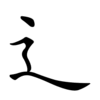This will be an exploration of the Chinese term Tao through a breakdown of the traditional Chinese characters.
Tao is a mysterious term, translated and understood in a variety of ways by hundreds of translators and commentators. One, a theosophists named Charles Johnston (see his translation and commentary here), notes that the term Tao is an equivalent of the Greek term Logos, of which many Theosophists are familiar. And indeed, when the term Logos is translated into Chinese, the word used is Tao (see, for instance, John 1:1 of the Christian bible in Greek and Chinese, with the King James English):
“Ἐν ἀρχῇ ἦν ὁ λόγος, καὶ ὁ λόγος ἦν πρὸς τὸν θεόν, καὶ θεὸς ἦν ὁ λόγος,”
“In the beginning was the Word (Logos), and the Word (Logos) was with God, and the Word (Logos) was God.”
“太 初 有 道 , 道 與 神 同 在 , 道 就 是 神”
“In the beginning was the Word (Tao), and the Word (Tao) was with God, and the Word (Tao) was God.”
When it comes to understanding the full meaning of the term Tao, we must look closely at the traditional character of the term itself. The Chinese language is written in a logosyllabic style, while English and other European languages are phonogramatic. This means that a character used for a Chinese word may hold a much greater meaning than the symbol-letters used in western languages. Complex Chinese characters may contain ‘hidden’ concepts in their various parts. So when we approach a term like Tao, it is beneficial to look not only at the way English translators have dealt with the word-meaning, but to go straight to the character itself and analyze its makeup. This is what I propose to do here.
First, let’s take a look at the complete character:

As a composite character this is often translated carrying these and similar meanings: “direction, way, method, road, path, principle, truth, reason, skill, measure, to say, to speak, to talk,” etc.. We can already get a sense of the meaning here if we look deeply into the combination of these English terms, but looking deeper into the character itself will aid us far more.
So, let’s take a look at how the character is written. This can help us see the various components that make up the full character (and we may, if we look closely, see an esoteric meaning to the order of the strokes, once we understand the meanings of each part).

We can immediately see two distinct characters that compose the whole. And we can divide these out easily.


Let’s look at the meanings of these two characters.
The first (辶, chuo) means “walk” or “walking”. You can see the symbolic nature of Chinese characters clearly here—the dash above being a head, then a body with an arm trailing behind (indicating forward movement), and below a path that the person is walking on. Beyond the simple idea of “walking” we ought to see a more subtle concept: that of movement. But not just movement, which could be haphazard, but rather: purposeful movement, or conscious movement, or movement in a certain direction or way, and so on. Take the concept of “walking” and expand it beyond the concept of a form with legs, and one will come closer to the ultimate meaning underlying the character.
The second (首, shǒu) carries the meanings: “head; chief; first (occasion); first (thing); leader,” etc.. But this is another complex character, composed of parts, and we can try to look closer at these. From the top to the bottom we can divide this into three parts, each carrying its own meaning.



Let’s take these in order, from left to right.
First we have 丷, a particle drawn from the character 為 (wéi), “to do” or “to be” (depending on usage).
Second we have 一 (yī) the simplest form of 弌, the number one. It thus carries the meaning of “one, single,” etc.
Third we have 自 (zì), which means “self” or “oneself”.
Stringing these together, we can see an expanded meaning to the term 首 (shǒu) as “to be one self” or “being oneself”. Theosophically speaking we can quickly see the significance of the idea of One Self, which is embedded in the concept of Tao (or Logos).
When we combine this with the meaning of 辶 (chuo), to walk (or to move, in the occult sense of the term, as related to Motion, Change, etc.), then we can really begin to grasp the fundamental meaning of Tao and to see why it is equated with Logos.
Our expanded meaning may come out something like this:
Tao: To be oneself in motion.
Tao: To move as One Self.
If we follow the order of the brush strokes in the original calligraphy, the meaning would come out as:
Tao: “To be One Self Moving.”
Or, if we wish to go further, we might say:
Tao: The Motion (and thus the Consciousness and Life) of the One Self.
Of specific interest to theosophists, and as a general footnote to this article, let’s take note of something interesting in the Chinese character for “self”:

Notice here that the character is composed of seven lines and/or brush strokes. One standing above the others; three enclosing and three enclosed.
We may also see more, if we look even closer. Notice that there is one stroke standing above and alone, then there are four horizontal strokes (four planes of manifestation?) and two vertical strokes on either side (the poles of spirit and matter, or akin to the pillars of Severity and Mercy in the Kabalistic Tree of Life?).
Chinese characters are very often pictographic, as we see clearly with the character for person (人, Rén)—standing upright with two legs—or as we saw with the character for “walking”. So it’s interesting that the character for “self” resembles nothing of a physical human being, but rather seems to resemble the esoteric symbolism of sevenfold Man.